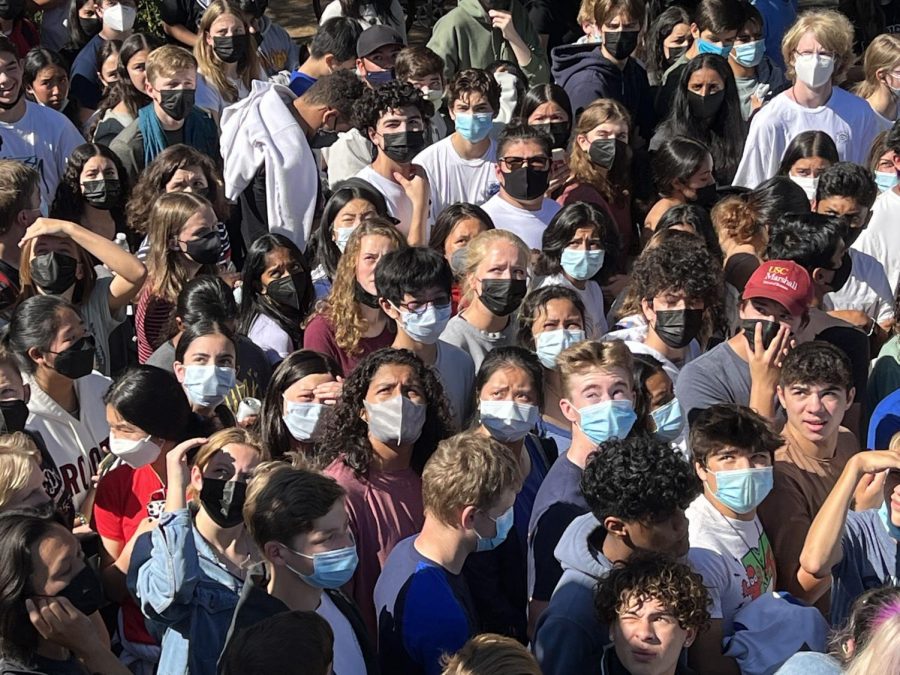LAHS bomb threat: The receipts
On Friday, October 1, an anonymous bomb threat was called in to Los Altos High School. In order to ensure student safety, LAHS used many internal and external resources; the community also provided LAHS with resources to evaluate the threat.
Following Los Altos High School’s October bomb threat, The Talon spoke with school and community representatives to provide holistic coverage of the event as well as its cost.
An unknown LAHS staff member received the anonymous threat through a phone call at 8:55 a.m. Within 90 seconds of the call, Principal Wynne Satterwhite was notified of the threat, and the authorities were called. Teachers were then notified to immediately evacuate students through an announcement on the loudspeaker. The fire alarm was not pulled in order to alert students and staff of the situation, which was a strategic choice, according to Satterwhite.
“There’s no way to quickly pull the fire alarm,” Satterwhite said, explaining why the administration decided against pulling the fire alarm. “Since we’ve implemented new technology in the classrooms, the fire alarm is triggered automatically. You’d have to walk down to a different space in order to manually activate the alarm.”
“Fire alarms increase people’s anxiety,” Satterwhite added. “We weren’t trying to do that at the moment.”
Within approximately 15 minutes, all students and teachers were evacuated to the field, and teachers were made aware of the nature of the situation through word-of-mouth by the staff-student liaisons, Seth Tasman and Julie Corzine.
Decisions such as moving students to the baseball field and bringing out water and food for students were all due to staff and administration’s discretion; administration was trying to make choices that would benefit students the best, according to Satterwhite. The biggest concern was having students out in the heat, so students were moved to an area with more shade. Although the move also heightened COVID-19 transmission concerns due to the compact nature of the space, the school offered extended COVID-19 testing every day for the next week. Students who needed additional assistance were brought into the portables, and met with counselors and teachers to address their needs.
While trying to maintain student comfort, LAHS provided students and staff with food from the school’s brunch and lunch supply for the day. Students were also given water from the school’s emergency resource bins.
While ensuring student safety and well-being, school administrators worked in tandem with local and national law enforcement to develop a plan of action for searching the school for the threatened incendiary device and the subsequent student and teacher evacuation.
Given the severity of the threat, as well as the number of students potentially impacted, the Los Altos Police Department worked with the Mountain View and Sunnyvale police departments to provide adequate surveillance of the scene. Local firefighters from the community were also present on campus along with the Santa Clara County Sheriff’s Office, Stanford Department of Public Safety, U.S. Coast Guard, the Department of Homeland Security and the Bureau of Alcohol, Tobacco, Firearms and Explosives Division. These agencies are called in any bomb threat situation, according to Satterwhite.
These agencies along with Emergency Medical Services stayed on campus for approximately four hours, assisting local law enforcement and also providing six explosive detection canines to aid in the search for the bomb.
“We’re extremely grateful for the support we received from our community,” Satterwhite said. “It was amazing.”
Students were permitted to leave campus at around 10:55 a.m, and the authorities completed their search determining the threat wasn’t valid around 2:00 p.m.
Teachers were then allowed to leave campus, and were paid for a full day of instruction. About 10 teachers stayed overtime to help conclude procedures at school and were paid for their time, according to Associate Superintendent of Business Services Mike Mathiesen.
“It’s hard to put a cost on the resources — both internal and external — that we used that day,” Mathiesen said. “There was an immense amount of support from our community, a cost would be hard to quantify, and there’s also an emotional cost with a lack of instructional time factored in.”
The student who called in the false bomb threat was identified earlier in November, and was “cited on multiple charges of making criminal threats and for making a false bomb report,” according to a Los Altos Police Department press release.
In order to improve the evacuation process, the LAHS administration sent out a survey to students regarding their experience and is analyzing the results to develop a larger plan for future emergencies.
“My biggest concern at the time was student safety,” Satterwhite said. “If I had to push over the fences to get students out, I would’ve.”





